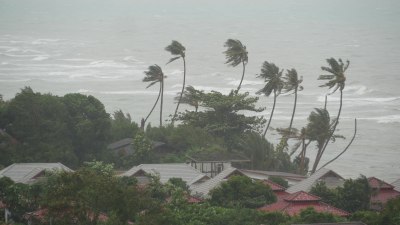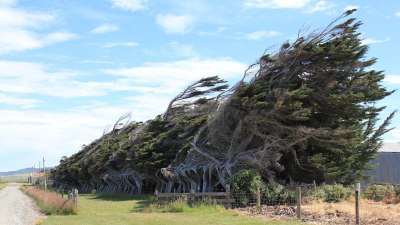Why Tropical Storms Sometimes Switch Directions Without Warning
Explore the reasons behind sudden changes in the direction of tropical storms and their impact on weather forecasting.

Tropical storms are some of nature's most powerful phenomena, and they often exhibit complex behaviors that can leave meteorologists scratching their heads. One of the most perplexing characteristics of tropical storms is their tendency to switch directions unexpectedly. This phenomenon can have significant implications for forecasting and disaster preparedness, and understanding the underlying factors is crucial for those living in storm-prone areas.
Tropical storms, also known as hurricanes or typhoons depending on their location, are intense circular storms that originate over warm tropical oceans. They derive their energy from the heat of the ocean and can bring heavy rains, strong winds, and storm surges. While meteorologists have made great strides in predicting the paths of these storms, certain conditions can lead to sudden changes in direction that are difficult to forecast.
Understanding the Basics of Tropical Storm Movement
To understand why tropical storms change direction, it's important to first grasp how they move. Tropical storms are influenced by a variety of factors including the Coriolis effect, steering currents, and atmospheric pressure systems. The Coriolis effect, caused by the Earth's rotation, influences the storm's rotation and contributes to its steering. Additionally, steering currents in the upper atmosphere can guide a storm along its path. These steering currents are generally composed of high and low-pressure systems, which can vary in strength and position.
Storms typically move westward due to the trade winds, but they can also curve poleward or even recurve back towards the equator depending on the interactions with these steering currents. However, when the balance of these forces changes suddenly, the storm can switch directions dramatically.
Key Factors Influencing Direction Change
Several key factors can cause a tropical storm to switch directions seemingly out of the blue:
1. Changes in Atmospheric Pressure Systems
When a high-pressure area builds in the vicinity of a tropical storm, it can alter the storm's path. High-pressure systems can act as barriers that push storms away, while low-pressure systems can attract them. If a storm encounters a strong low-pressure area, it may veer towards that region unexpectedly.
2. Interaction with Other Weather Systems
Tropical storms can also experience significant directional changes due to interactions with other weather systems, including cold fronts, warm fronts, and mid-latitude cyclones. For example, as a tropical storm approaches a cold front, it may be pulled off its typical westward trajectory, causing it to shift directions as it interacts with the different temperature and pressure zones. This interplay of systems can create sudden shifts that are hard to predict.
3. Ocean Currents and Sea Surface Temperatures
Ocean currents significantly impact tropical storm behavior. Warmer waters can enhance storm strength, while cooler waters can diminish it. If a storm moves into an area where the water temperature significantly drops, it may weaken and change direction as it seeks warmer waters. The position of ocean currents can also redirect storms, influencing their paths and categories.
4. Topography and Land Interaction
When tropical storms make landfall, they no longer have the warm ocean water to fuel their intensity. Furthermore, the presence of land can alter wind patterns, leading to unexpected directional shifts. Mountain ranges, for instance, can channel winds and force the storm to change course. As a storm moves across land, it can generate erratic motions influenced by the terrain it interacts with.
5. Numerical Weather Prediction Models
Forecasting models have improved dramatically, but they are not infallible. Tropical storms are complex systems influenced by numerous variables, making precise predictions challenging. When model inputs change—such as data about ocean temperatures, wind speeds, or atmospheric pressure—predictions about a storm's path may also change. This can lead to surprise shifts in direction that catch forecasters off guard.
Case Studies of Notable Direction Changes
Throughout history, there have been several notable cases where tropical storms changed direction unexpectedly, resulting in significant impacts:
Hurricane Florence (2018)
In September 2018, Hurricane Florence was projected to make landfall in South Carolina but suddenly changed direction heading towards North Carolina due to a nearby high-pressure system. This unexpected shift brought extensive flooding and damages that were initially unforeseen.
Hurricane Irma (2017)
Hurricane Irma prompted warnings across Florida as it was forecasted to take a particular path. However, it dipped below expected projections and shifted direction to target the Florida Keys. This change highlighted the unpredictability of storm trajectories and the importance of staying vigilant.
Tropical Storm Barry (2019)
Tropical Storm Barry displayed erratic behavior as it navigated the Gulf of Mexico. Initially projected to move northward, Barry unexpectedly shifted westward, which altered evacuation plans in Louisiana and caused last-moment adjustments in preparedness measures.
Understanding the factors that cause tropical storms to change direction is vital for those living in vulnerable areas. While meteorologists continue to improve forecasting techniques, the inherent unpredictability of these storms emphasizes the need for readiness. Communities should remain informed, heed warnings, and take storm preparedness seriously to mitigate risks associated with sudden direction changes. While scientists work to enhance predictive models, it’s crucial to respect the power of nature and be aware of the potential for unexpected events.











